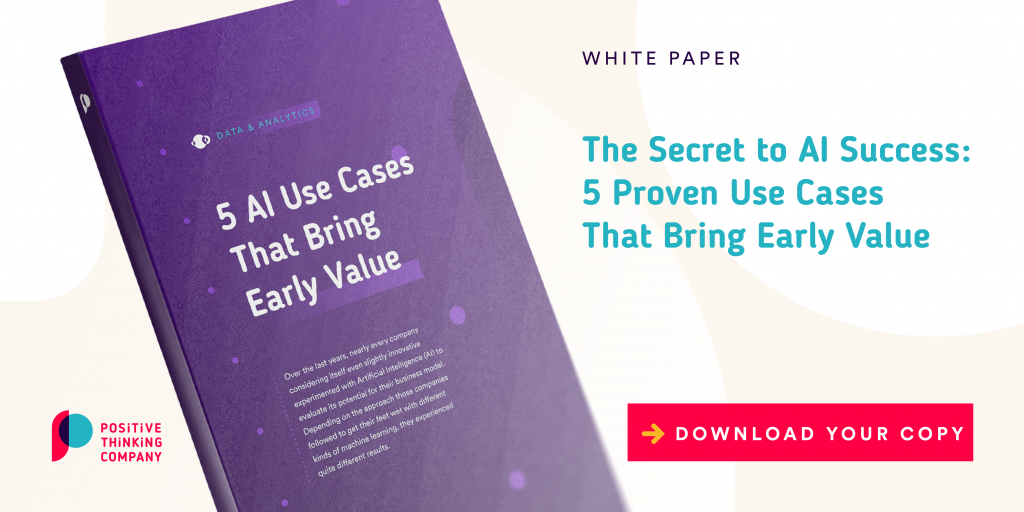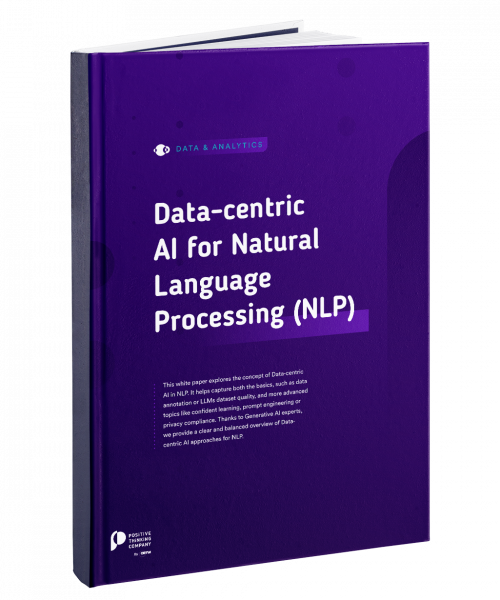In 2023, the landscape of Artificial Intelligence (AI) continues to evolve, with recent advancements in Generative AI painting a promising picture for businesses striving for innovation. Most companies have already moved beyond the hype and excitement phase of their AI journey. They’ve put in the time to experiment with and understand the true potential of AI for their business. They now want to move up the AI maturity ladder towards large scale operationalization of AI use cases to realize the benefits of AI in their day-to-day operations. And thus, move their business closer towards a truly data-driven organization.
Unfortunately, making this step gives rise to a whole number of new challenges. And these challenges must be addressed. Handling them with a well-designed AI Strategy unlocks major advantages. Let us describe the three most important ones to you in more detail.
1. Build the right things

Simultaneously facing lots of AI initiatives from the inside as well as success stories from the outside, most companies started their AI journey by experimenting. They conducted a number of Proof-of-Concepts (PoCs) that might or might not have succeeded. This is an important step in the beginning of every company’s AI journey: It is essential to familiarize oneself with the look and feel of AI and to cut through the hype. By doing so, you acquire the necessary experience and knowledge to truly understand what AI can and cannot do for your business. As long as you are in the explorative phase of adopting AI, it may be totally acceptable to have as many success stories as failures. But, once you’ve reached a certain level of maturity and start to go from experimentation to operationalization, the environment changes. To successfully make this transition, identifying, prioritizing, and selecting the right use cases to move forward with becomes critical.
Consequently, one of the most important – and often first – steps of setting up your AI strategy is the development of a clear AI roadmap (as shown in the examples below).This allows you to accurately compare different use cases by correlating the expected future value of each use case with its individual likelihood of success and thereby estimating the individual risk-return-ratios.
Example: Use Cases (Overview)

Example: Final Analytical Roadmap

Trough visualizing your use cases in a value-feasibility-matrix, it becomes easy to identify the low hanging fruits that bring early value at low risk before moving towards riskier use cases. By following this approach, the first major benefit of a well-designed AI strategy is unlocked: Ensuring that you build the right things at the right time.

2. Build things right

Once you’ve chosen the most-promising use cases, you’ll want to make sure to implement them the best way possible. A well-designed AI strategy helps you to develop the organizational structure necessary to pave the way for any AI use case afterwards. More precisely, it allows you to bring order to two dimensions: 1) structure and processes and 2) infrastructure and tools.
First, to prevent common pitfalls such as multiple data silos, parallel projects, hidden know-how or unclear responsibilities, new structures and processes need to be implemented. This helps to centralize aspects, prevent uncontrolled growth, create ownership and bring together your data in one location. Because when it comes to AI, more data is better data.
Setting up a central infrastructure for organization-wide, central collaboration instead of distributed competition enables you and your company to design good AI products. The key word here is scalability. Research shows that companies spend more and more time on the deployment and the operationalization of ML models and therefore less time on developing and improving such models as the number of productionized models grows (Algorithmia Research (2021): “2021 enterprise trends in machine learning”). By choosing the right infrastructure and tools, you will avoid falling into this deployment trap.
A well-designed AI strategy helps you to set up the right structures and processes, make sure the right data is collected and chose the right infrastructure and tools. It enables you to build things right.
3. Get into the right mindset

Even the best structures, processes, tools and infrastructures can not create value if they aren’t properly utilized. One of the key challenges in AI is convincing people to adopt it.
Transparency and early involvement allow stakeholders to see and understand the true implications of AI for their work experience. Often, especially those who posses the key business and process knowledge required to build an amazing AI system are those who feel the most threatened by it (e.g. Customer Service Agents vs. Chatbots). A properly defined AI strategy helps them to understand AI as a support system, not a threat. Subsequently, fear decreases, and the stakeholder involvement increases. Once you reach this point, you can tap into the valuable knowledge of your business stakeholders and integrate it into your AI products. Share with them your vision where AI doesn’t replace but support them to get them on-board and unlock their knowledge.
From a design perspective, bringing all stakeholders to the table and integrating them into the AI development process early on allows you to investigate, understand and integrate their individual needs. This helps to prevent the ivory tower syndrome – developers building fancy stuff nobody needs – and to actually build the things your stakeholders want and need.
A well-designed AI strategy is the foundation for changing your company culture into the right mindset to really capture the value of AI. A transparent and easy to communicate AI strategy that aligns stakeholders and brings them to the table early on leads to stakeholder buy-in and opens up the door for truly user-centered design.
How to develop an AI strategy that gives rise to those benefits?
We at Positive Thinking Company can help you to get there. We have years of extensive experience in sparking enthusiasm in and aligning stakeholder, assessing AI use cases and setting up processes and infrastructure.
We are both holistic data strategist and seasoned technical implementers.
This puts us in a unique position to combine both points of view:
- We co-build with you an AI Strategy that is focused on business value on the one hand and technical feasibility on the other. By applying our proven AI roadmap methodology, we empower you to build the right things. We are capable of assessing your current situation and the future value of your potential use cases, from a management point of view, and their technological feasibility, from an engineering perspective.
- As we work with infrastructure components and specific tools in our daily consulting lives, we help you to introduce tailor-made processes, infrastructure, and tools to build things right!
- It is in our DNA to cooperate closely with business departments and their users. We are well experienced in addressing their concerns and coaching them to use the final AI solutions. We know very well that even the best solutions fail without stakeholder buy-in. Therefore, we put our focus on creating expectations rooted in reality, communicating the true capabilities of AI to stakeholders and even showing them hands-on why they should not be threatened by but eager to adopt AI. We bring the right mindset to your company!












